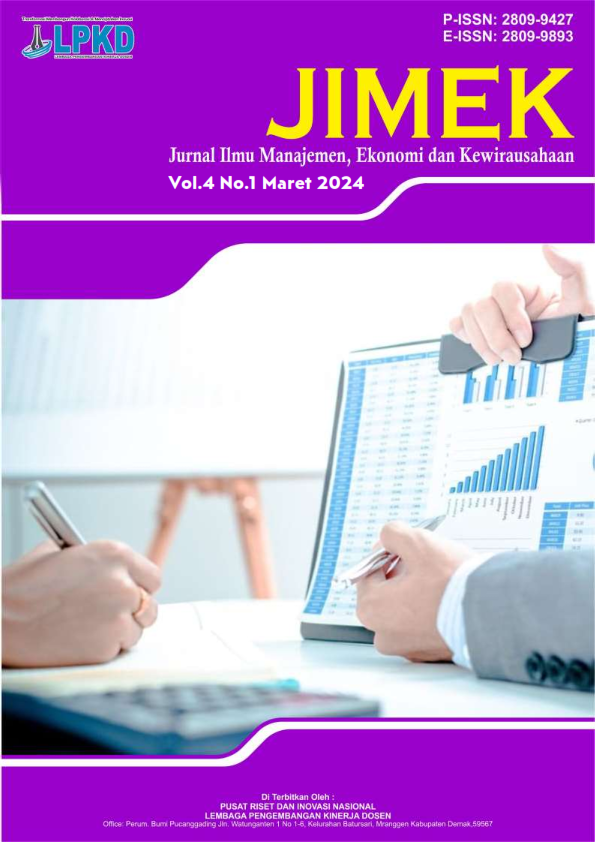Pengaruh Beban Kerja dan Job Insecurity terhadap Turnover Intention melalui Kepuasan Kerja
Studi Kasus pada PT Java Wood Industri
DOI:
https://doi.org/10.55606/jimek.v5i1.6533Keywords:
job satisfaction, job insecurity, turnover intention, workloadAbstract
This study aims to analyze the influence of workload and job insecurity on turnover intention through job satisfaction as a mediating variable at PT Java Wood Industri. The research uses a quantitative explanatory approach with a sample of 303 employees selected through proportional random sampling. Data were collected using a questionnaire and analyzed using Structural Equation Modeling (SEM) with AMOS 26. The results show that workload has a significant positive effect on turnover intention, while job insecurity does not significantly affect turnover intention. Job satisfaction also has a significant positive effect on turnover intention. However, neither workload nor job insecurity significantly affects job satisfaction, and job satisfaction does not mediate the relationship between workload/job insecurity and turnover intention. The findings suggest that companies should focus on managing workload and improving job satisfaction to reduce employee turnover intention.
References
Anshari, M., & Kuncoro, M. (2013). Pengaruh job insecurity terhadap turnover intention. Jurnal Psikologi Industri dan Organisasi, 2(1), 45–53.
Bogar, N. R., Santosa, S., & Rini, A. S. (2021). Pengaruh beban kerja terhadap kinerja karyawan. Jurnal Ilmu Manajemen Terapan, 12(2), 123–130.
Cole, M. S., & Castro, S. L. (2023). Examining the turnover process: A review and future directions. Journal of Organizational Behavior, 44(1), 33–50.
Febriastuti, N., Sari, D. P., & Hidayat, R. (2019). Analisis beban kerja dan dampaknya terhadap kepuasan kerja. Jurnal Manajemen dan Bisnis Indonesia, 9(1), 51–60.
Febriyanti, M., & Yulianingsih, E. (2021). Beban kerja dan kepuasan kerja terhadap turnover intention. Jurnal Administrasi dan Bisnis, 12(1), 77–84.
Gayatri, F., & Muttaqiyathun, A. (2020). Job insecurity dan dampaknya terhadap kepuasan kerja karyawan kontrak. Jurnal Psikologi, 11(2), 102–111.
Herawati, R., Suryadi, S., & Lestari, M. (2023). Kepuasan kerja sebagai penentu kinerja karyawan. Jurnal Sumber Daya Manusia, 8(1), 67–76.
Indrayani, I. M., & Sudibya, A. A. G. (2017). Pengaruh job stress terhadap turnover intention. E-Jurnal Manajemen Unud, 6(5), 2512–2539.
Li, N. (2008). Job satisfaction as a mediator of the relationship between workload and performance. Journal of Applied Psychology, 93(1), 123–131.
Luthans, F. (2011). Organizational behavior (12th ed.). McGraw-Hill Education.
Mansoor, M., Fida, S., Nasir, S., & Ahmad, Z. (2011). The impact of job stress on employee job satisfaction. Journal of Business Studies Quarterly, 2(3), 50–56.
Mustapha, N., & Yu Ghee, W. (2013). Examining turnover intention among academic staffs. International Journal of Business and Social Science, 4(8), 96–103.
Nurhasanah, S., Rahmawati, R., & Pramesti, D. (2022). Kepuasan kerja dan niat pindah kerja. Jurnal Ilmu Ekonomi dan Manajemen, 6(2), 119–128.
Purwati, A. A., & Maricy, M. (2021). Beban kerja dan turnover intention: Studi pada industri tekstil. Jurnal Manajemen dan Bisnis, 13(1), 98–106.
Purwati, A. A., Riyadi, S., & Setiawan, D. (2020). Peran strategis SDM dalam meningkatkan kinerja perusahaan. Jurnal Ekonomi dan Manajemen, 18(2), 71–80.
Saputri, N. F., Utami, R. A., & Wardhani, N. P. (2020). Analisis turnover intention dengan pendekatan model Meyer. Jurnal Manajemen Strategi dan Aplikasi Bisnis, 3(2), 85–94.
Smithson, J., & Lewis, S. (2000). Job insecurity and psychological well-being. British Journal of Psychology, 91(4), 521–539.
Sundari, S., & Meria, L. (2022). Turnover intention dalam perspektif kepemimpinan dan lingkungan kerja. Jurnal Manajemen Sumber Daya Manusia Indonesia, 6(3), 143–151.
Suwatno, S. (2013). Manajemen sumber daya manusia dalam organisasi publik dan bisnis. Refika Aditama.
Zammitti, A., Aiello, A., & Sorgente, A. (2023). The relationship between job insecurity and well-being. International Journal of Environmental Research and Public Health, 20(2), 565–579.
Downloads
Published
How to Cite
Issue
Section
License
Copyright (c) 2025 Jurnal Ilmu Manajemen, Ekonomi dan Kewirausahaan

This work is licensed under a Creative Commons Attribution-ShareAlike 4.0 International License.








